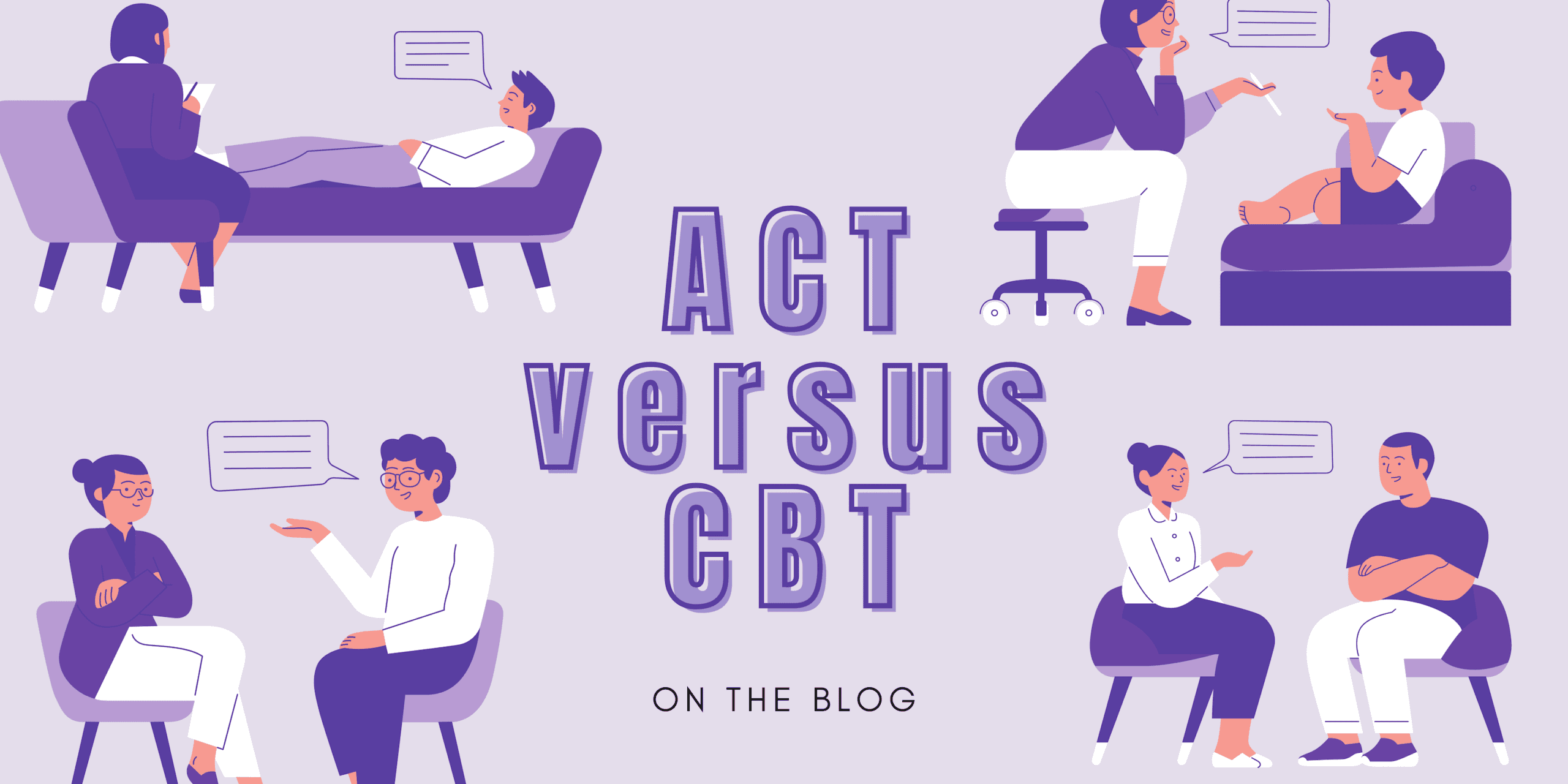
If you’re looking at undertaking some sort of therapy for your chronic pain management, there are two that can be highly effective. It is worth it to know about Acceptance and Commitment Therapy (ACT) and Cognitive Behavior Therapy (CBT). For those who suffer from chronic pain, you’ll likely be aware that there are many different ways to help manage it. Thus, you have various options that go from medication and lifestyle changes to therapy and physiotherapy. However, they always forget the importance of talk therapy that can effectively improve chronic pain as it deals with the mental and emotional aspects of pain. Therefore, this article will give you more knowledge about ACT vs CBT therapy. And CareClinic app will help you track the symptom you are experiencing and help you track your medication plan
Understanding ACT – Cognitive Therapy
Acceptance and Commitment Therapy (ACT) encourages people to embrace their thoughts and feelings rather than fighting or feeling guilty for them. ACT develops psychological flexibility. It is also a form of behavioral therapy that combines mindfulness skills with the practice of self-acceptance. When aiming to be more accepting of your thoughts and feelings, commitment plays a key role.
Developed within a coherent theoretical and philosophical framework, Acceptance and Commitment Therapy (ACT) is a unique empirically based psychological intervention that uses acceptance and mindfulness strategies, together with commitment and behavior change strategies, to increase psychological flexibility. Psychological flexibility means contacting the present moment fully as a conscious human being and based on what the situation affords, changing or persisting in behavior in the service of chosen values.
Six Principles of ACT Behavioral Therapy
Six basic principles form the foundation of Acceptance and Commitment Therapy. They work in conjunction with one another toward the main goal. The main goal of effectively handle painful thoughts and experiences and create a rich, vital life. Thus, The six principles are:
- Cognitive diffusion (which means separating from your thoughts, and looking at them rather than from them)
- Expansion and acceptance (the practice of making room for all the unpleasant emotions/sensations we feel, rather than trying to ignore them)
- Contact and connection with the present moment (to feel our emotions/sensations, we must first be connected to ourselves and the present)
- The Observing Self (an all-encompassing awareness of yourself, from a non-judgmental mindset)
- Clarification of values (getting clear on the most important things to us, such as loyalty, love, happiness, morality, and compassion)
- Committed action (setting goals and taking active steps towards achieving them through commitment)
Benefits of ACT
The key benefits of ACT is that it can help patients battle mental disorders like anxiety and depression without using medication. It teaches patients to change the way they relate to their negative thoughts and emotions so that these thoughts don’t take over. While patients may not be able to eliminate all pharmaceutical medications right away, they may be able to reduce their dosage over time, ultimately going off the medication completely. With the opioid crisis being such a hot topic in the medical and psychological fields, it is promising to have effective treatment alternatives that don’t require medication.
If you have a migraine with aura, you may have additional migraine symptoms. Vision disturbances such as iridescent spots or blinking lights, numbness or tingling are all possible symptoms of allergy migraines that include aura. These symptoms can appear minutes or even half an hour before the migraine starts. Most people with allergy migraines face postdrome sickness. A “migraine hangover” is the common name for the postdrome migraine stage. The resulting migraine hangover or the postdrome stage refers to the lingering pain. This pain can be present through the entire body or a specific area. These are the last few hours of the pain in the migraine stage, hence, the symptoms are less in severity. To read more about postdrome migraines, check out our blog post here.
ACT has shown promise for a wide range of physical and psychological conditions. It is often applied in situations involving depression, obsessive-compulsive disorder, post-traumatic stress disorder, and even psychosis. It can also be useful in helping patients deal with overwhelming stress and many forms of anxiety. Practitioners have also used it to treat medical conditions like substance abuse, chronic pain, and diabetes.
How to find an ACT Therapist?
ACT is typically provided by licensed professional counsellors, social workers, or psychologists. Usually, ACT therapy occurs in weekly outpatient sessions lasting about an hour. ACT treatment typically lasts between 8-16 weeks, although this can vary, depending on the individual needs and goals of each client.
Many people are also interested in finding a therapist who is in-network with their insurance. Contacting your insurance company is also a good way to find an in-network therapist. Usually, the best way to begin this process is to either call the number on the back of the insurance card or to use the insurance company’s website to conduct a search for in-network counsellors.
Understanding CBT Therapy
Cognitive-behavioural therapy (CBT) focuses on how your thoughts, beliefs, and attitudes affect your feelings and behavior and teaches you coping skills for dealing with different problems. Traditional Cognitive Behavioral Therapy (CBT) comprises a group of psychotherapy techniques and approaches. These target thoughts, sensations, and actions that are considered negative or destructive. Treatment is geared towards change through classical conditioning principles.
The therapist plays an active role to help you recognize thought patterns that have a negative influence on your behavior and emotions. Those are then challenged to come up with objective ones that help eliminate symptoms of disorders like anxiety and depression.
Different Types of Cognitive Behavioral Therapy (CBT)
There are a number of different Cognitive Behavior Therapies, and a number of Behavior Therapies that may be included by some under CBT as well, even if their developers believe they are more accurately identified as Behavior Therapies, like Acceptance and Commitment Therapy (ACT). Some forms of Cognitive Behavior Therapy (CBT) you may encounter include:
- Cognitive Processing Therapy (CPT)
- Cognitive Therapy (CT)
- Dialectical Behavior Therapy (DBT) – Compare CBT vs DBT
- Rational Emotive Behavior Therapy (REBT)
- Self-Instructional Training
- Stress Inoculation Training, etc.
How does CBT Work?
CBT is based on the concept that your thoughts, feelings, physical sensations, and actions are interconnected, and that negative thoughts and feelings can trap you in a vicious cycle. It also aims to help you deal with overwhelming problems more positively by breaking them down into smaller parts. It shows how to change these negative patterns to improve the way you feel. Unlike some other talking treatments, CBT deals with your current problems, rather than focusing on issues from your past. It looks for practical ways to improve your state of mind daily.
Moreover, in CBT you work with a therapist to identify and challenge any negative thinking patterns and behavior which may be causing you difficulties. In turn, this can change the way you feel about situations, and enable you to change your behavior in the future. You and your therapist might focus on what is going on in your life right now, but you might also look at your past, and think about how your past experiences impact the way you see the world.
Understanding the Uses for CBT Behavorial Therapy
CBT has been shown to be an effective way of treating a number of different mental health conditions. In addition to depression or anxiety disorders, CBT can also help people with:
- bipolar disorder
- borderline personality disorder
- eating disorders such as anorexia and bulimia
- obsessive-compulsive disorder (OCD)
- Panic disorder
- phobias
- post-traumatic stress disorder (PTSD)
- psychosis
- schizophrenia
- Sleep problems such as insomnia
- problems related to alcohol misuse
CBT is also sometimes used to treat people with long-term health conditions, such as:
- irritable bowel syndrome (IBS)
- Chronic fatigue syndrome (CFS)
- fibromyalgia
Although CBT cannot cure the physical symptoms of these conditions, it can help people cope better with their symptoms.
How CBT Therapy Can Assist Users
With this theory in mind, CBT aims to teach patients how to change their thoughts and behaviors, specifically those which cause the patient great harm and/or distress.
CBT can assist in treating things like:
- Anxiety and anxiety-related disorders
- Depression
- Irrational fears
- Substance abuse
- Addictions such as gambling
- Insomnia
- Disordered eating
- Schizophrenia
- Phobias
- Post-Traumatic Stress Disorder
- Obsessive-Compulsive Disorder
- Sleep Disorders
- Bipolar Disorder
Assumptions About CBT Therapy
CBT therapy works to change what’s known as “basic irrational assumptions”. Those are the thoughts that a large majority of people have, yet aren’t aware that they’re not correct in thinking that way. Irrational assumptions can include things like:
- people believe that you should be thoroughly competent at any task you try
- Or they believe that things are catastrophic and doomed if they’re not how you’d like them to be.
- You have no control over your own happiness.
- Some people believe that you need someone ‘better’ than you to depend on.
- They believe that anything done in your past is greatly influencing your present.
Understanding the Strategies of CBT
CBT treatment usually involves efforts to change thinking patterns. These strategies might include:
- Learning to recognize one’s distortions in thinking that are creating problems and reevaluate them in light of reality.
- Gaining a better understanding of the behavior and motivation of others.
- Using problem-solving skills to cope with difficult situations.
- Learning to develop a greater sense of confidence in one’s own abilities.
CBT treatment also usually involves efforts to change behavioral patterns. These strategies might include:
- Facing one’s fears instead of avoiding them.
- Using role-playing to prepare for potentially problematic interactions with others.
- Learning to calm one’s mind and relax one’s body.
How Effective is CBT?
Research shows that CBT is the most effective form of treatment for those coping with depression and anxiety. CBT alone is 50-75% effective for overcoming depression and anxiety after 5 – 15 modules. Medication alone is effective, however, science still does not understand the long-term effects on the brain and body. Medication and CBT combined are most effective in helping people overcome mental illness.
What are the differences between ACT vs CBT?
CBT and ACT are both behaviour-based therapies, but they differ primarily in the view they take around thoughts. While CBT works by helping you identify and change negative or destructive thoughts, ACT holds that pain and discomfort are a fact of life. This is something we must get comfortable with if we wish to live a happy, fulfilled life. For this reason, ACT encourages you to accept all thoughts rather than trying to change them – both the good and the bad. CBT therapists encourage clients to reframe or rethink their thoughts in more helpful ways that lead to improvements in their emotional state and behavior. ACT therapists believe that putting effort into rethinking or changing thoughts is unhelpful and sometimes can lead to becoming more stuck.
CBT is a short-term, evidence-based therapy that has been around since the 1950s. It’s focusing on helping people challenge and change destructive thought and behavioral patterns. The “Third wave” therapy is the name that refers to ACT therapy. It’s a therapy that moves beyond the more traditional cognitive therapies and adds other skills into the mix. For instance, mindfulness, visualization, personal values, etc. In the ACT, symptom reduction is not a goal but rather a desired side-effect.CBT is highly goal-oriented and focused on change.
Compare and Contrast the two therapies below:
ACCEPTANCE AND COMMITMENT THERAPY TECHNIQUES (ACT)
- Focused on accepting that negative thoughts, feelings, emotions, memories, and behaviors are a part of life
- Control over the therapy is divided between the therapist and patients
- Eliminating symptoms of depression and anxiety are a side-effect
- Treatment can be short-term or long-term
- Effective as individual, couple, and group therapy
- Quick results
COGNITIVE-BEHAVIORAL THERAPY TECHNIQUES (CBT)
- Focused on change of negative thoughts, emotions, and behavior
- The therapist plays a large role
- The goal is to eliminate symptoms of depression and anxiety
- Often a short-term treatment
- Difficult to adapt as group therapy
- Targets specific psychological problems
- Gradual process
Is ACT vs CBT More Effective?
Both the ACT and CBT interventions showed a large, statistically significant, and stable symptom reduction over six months across all outcomes. Both approaches led to a small improvement in life satisfaction. With regards to depressive symptoms, more than half of the patients reliably recovered due to therapy. ACT and CBT were similarly effective in treating patients with depressive and other mental disorders in a routine clinical setting. ACT is a viable alternative to CBT for treating inpatients.
Leveraging Digital Health Solutions
The CareClinic app is a one-stop health app that provides countless traits that help patients stay on track with their medical prescriptions, diets, physical activities, supplements, and therapies and create self-care. The app comes with a daily check-in feature that includes medicine and supplements, symptoms tracker, measurements, nutrition tracker, activity tracker, sleep tracker, etc. Through the app website, you have access to different articles that can help you. Additionally, the app gives you the possibility to create your own personalized care. Once you do that your doctor and family can have access to your plan and it becomes easier to follow your treatment.
Diary Tracking for ACT vs CBT Therapy

Additionally, in the diary feature, you can note all pros and cons of Acceptance and Commitment Therapy (ACT ) and Cognitive-behavioral therapy (CBT). The app also provides access to a space where you can add lists, bold, italicize, and underline important statements. In-app users are also able to add photos to personalize their diary tracking. And the best part of it is that diary entries are automatically saved to return to and work on the next day.
Symptom Tracking

Keeping a Log of Medications

Leveraging Digital Health Strategies
Telling the difference between ACT and CBT may be confusing. Both are rooted in behavior therapy. While traditional CBT focuses on eliminating unpleasant feelings and emotions, ACT concentrates on their acceptance. The second approach works to improve the quality of life while recognizing that not all sensations are pleasant or should be eliminated. After reading this article we hope that you get a better understanding of how ACT and CBT therapy works and what are the differences. People who are doing the ACT and CBT therapy can start tracking their process via the CareClinic app.


